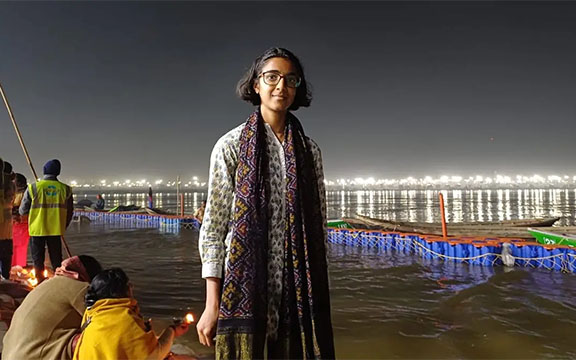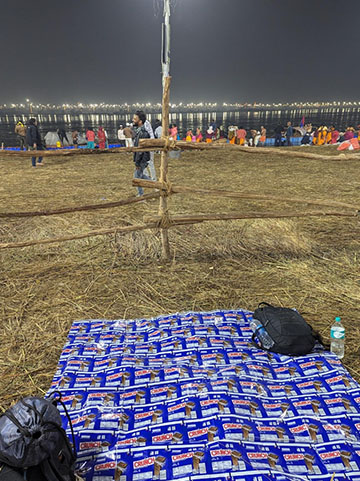
Samyukta Shrivatsa at the Kumbh Mela in Prayagraj, 2025 (courtesy: Samyukta Shrivatsa)
On one fateful Wednesday night in January, I texted a friend words I never thought I would say: “I just decided to go to Maha Kumbh. I’m leaving tomorrow.” As a chronically over-working PhD student, my connection to my Indian Hindu roots was limited to saying a quick prayer and putting a streak of vibhuti (sacred ash) on my forehead before an important exam or a dicey meeting with my advisor.
I will probably never be able to explain what led me to pack two sets of clothes in my Stanford backpack and embark on a once-in-a-lifetime journey along 650 million others who were answering the same call—to attend the Maha Kumbh Mela, the largest gathering of humanity ever. However, the journey there and the ritual dip at the Triveni Sangam – the sacred confluence of the rivers Ganga, Yamuna, and Saraswati – proved to be a profoundly transformative experience that I will always be grateful for.
Prayagraj
My previous trips to India were scheduled to the minute, often driven by the usual concerns around safety that bedevil the travels of a young woman anywhere in the world. This time, with no set plans, in 36 hours, I found myself flying to the temple town of Varanasi, taking a well-worn bus toward the holy city of Prayagraj, and when the bus stalled in traffic for hours, weaving through narrow gullies in a rickshaw and then by foot. Nothing truly registered until I stood at the edge of the Kumbh Mela at sunset, breathing in the scent of ritual smoke, listening to chants, and moving through a throng of devotees from every corner of the world and all walks of life.
The sides of the mud lanes were lined with tents set up by akharas, or the historic religious sects within Hinduism, each with its traditions and followers from around the country. Among them, the Kinnar Akhara, a sect led by and for transgender devotees, stood out with its vibrant presence, a powerful testament to the inclusivity and depth of spiritual life at the Kumbh Mela.
I had travelled to the largest gathering of humanity without even bothering to book a lodging in advance. So when I finally arrived at the banks of the Triveni Sangam, I simply set up “camp” for the night. Or rather, I spread out a plastic sheet made from recycled Crunch bar wrappers, being sold by roadside vendors catering to unprepared travelers like me, and used my backpack as a pillow. I was lulled to sleep by the sound of neighboring groups playing instruments and singing devotional bhajans, feeling an unbelievable level of safety and comfort in the company of total strangers.
At one point during the night, I woke up and had the horrific realization that my phone was missing. As I sank into a cold sea of sheer panic and contemplated calling my mom (with what phone?), my neighbor groggily sat up and, to my great relief, held it out to me. Apparently, it had slipped out of my pocket in the night, and a kind passerby had handed it to them for safekeeping. Dharma was truly protecting me.

Shrivatsa’s campbed at the Kumbh Mela (image courtesy: Samyukta Shrivatsa)
Shahi Snan (Sacred Dip)
In the cold, foggy hour of Brahma Muhurtam, just before sunrise, I finally took the same dip that generations of my ancestors have taken, believing it frees one from the cycle of rebirth, washes away sins, and grants spiritual liberation. I had so many things I meant to ask for. In the short moments I spent in the water, however, I couldn’t think of anything beyond how amazing it was to be in those waters, carried down over centuries from the Gangotri glacier in the Himalayas, touching millions of lives and inspiring generations of scholars, artists, and storytellers.
Beyond the sacred dip itself, my experience at the Kumbh Mela revealed something deeper – the collective unity we are always a part of and the need to pause to embrace it. Amidst the dazzling strangeness and endless sights, the moments I felt most connected were those spent sharing simple roadside meals with fellow travelers – prasada or ritual offerings made to a deity, distributed freely and generously to every passerby.
At Kumbh, my literal and metaphorical Stanford backpack was meaningless when thousands of seekers surrounded me, each carrying their own burdens, hopes, and stories. In that vast sea of humanity, stripped of titles and accolades, I was simply another soul drawn to the river, searching for something beyond myself.
About the Author:
Samyukta Shrivatsa is a PhD student in civil and environmental engineering at Stanford University. She also serves as co-president of the Stanford India Policy and Economics Club and volunteers with CoHNA. (Reprinted with permission from India Currents).

